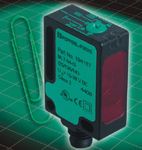In the Spotlight May 2008
Editors' Picks of Pharmaceutical Science & Technology Innovations
Sensors feature new certifications and modes
The "ML7" series miniature photoelectric sensors from Pepperl and Fuchs (Twinsburg, Ohio) have received an IP69k protection rating and can now be used for high-pressure, high-temperature washdown applications. In addition, Ecolab (Düsseldorf, Germany) certified that the sensors are compatible with many common cleaners and caustic cleaning chemicals.

ML7 photoelectric sensor (Pepperl and Fuchs)
Jeff Allison, product manager of photoelectric sensing at Pepperl and Fuchs, remarks that the ML7 units now feature a clear-object sensing mode. This mode detects slight fluctuations in reflected light. "The sensing hysteresis is more sensitive to clear objects and plastics than a regular retroreflective would be," Allison explains. Operators adjust the devices' potentiometer to control the units' contrast levels.
The sensors also operate in diffuse mode with background suppression, which inherently has low color sensitivity, Allison explains. This mode reduces the sensing-range difference between colors to less than 10%.
Technology provides secure authentication
Cortegra's (Parsippany, NJ) "Biometric Authentication Technology" provides an anticounterfeiting solution for various points in the pharmaceutical supply chain. Using optical electronics, the technology scans a 0.5-in.2 area of packaging material to collect information about its natural microstructures.

Biometric Authentication Technology (Cortegra)
The product's software converts this information into a digital signature to which only 1 in 1027 products have identical configurations. The technology can create digital signatures in forms such as 2D barcodes or radio-frequency identification. These signatures store data such as packaging-material characteristics, lot number, and date codes.
Portable TOC sensor provides flexibility
The "CheckPoint" total organic carbon (TOC) sensor from GE Analytical Instruments (Boulder, CO) is the first battery-powered unit of its kind, according to Jon Yourkin, GE's pharmaceutical product manager. The portable sensor offers "the opportunity to sample points of use on an ultrapure water system that might not be accessible with an on-line instrument," Yourkin says.

CheckPoint sensor (GE Analytical Instruments)
The sensor also can be used on line, he adds. The unit provides 4 h of continuous, on-line use without requiring AC power. The instrument includes brackets that allow easy mounting and dismounting.
The CheckPoint device provides test results in 15 s. Users can easily program the unit to display results in various formats at intervals as great as 8 h.
Yourkin adds that the sensor's pump head is its only moving part. The machine's key components can be removed quickly for easy maintenance.
New Product Announcements
May be sent to New Products Editor, Pharmaceutical Technology, 485 Route One South, Building F, First Floor, Iselin, NJ 08830, fax 732.596.0005, ptpress@advanstar.com

Drug Solutions Podcast: A Closer Look at mRNA in Oncology and Vaccines
April 30th 2024In this episode fo the Drug Solutions Podcast, etherna’s vice-president of Technology and Innovation, Stefaan De Koker, discusses the merits and challenges of using mRNA as the foundation for therapeutics in oncology as well as for vaccines.